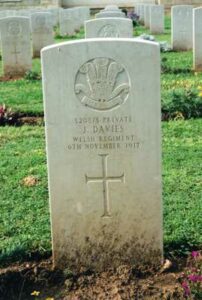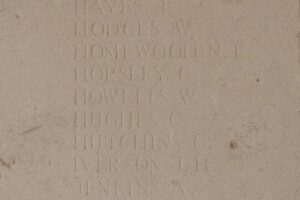The small community of Llangain is situated in a pleasant location in the Towy Valley, about four miles south of Carmarthen on the road to Llansteffan. The War Memorials for the men of Llangain who fell during both World Wars are located on memorials located inside Smyrna Independent Chapel and inside the village Memorial Hall. Smyrna Chapel also contains a framed memorial which contains photographs of the men connected with the Chapel who served during the Great War. There is also a separate memorial inside Llangain Church to William David Davies. There is a mistake on the memorial inside the hall, as it shows that one man served with the A.E.F., while he actually served with the A.I.F. which is correct on the original memorial. The photographs of the memorials were kindly sent in by my former R.E. teacher at Whitland, Haydn Williams, while Dr Gethin Matthews has recently sent in photographs of the portraits in Smyrna. This page commemorates the men named on the memorials within Smyrna Chapel.
The Great War, 1914-1918

John Davies, Private, 320373, Welsh Regiment. John was the son of John and Mary Davies, of Factory Road, Llansteffan, and lived at Glyn Cottage, Llangain. He enlisted at Carmarthen into the Pembroke Yeomanry in June 1915, and moved to Egypt with the battalion in 1916. The Pembroke Yeomanry merged with the Glamorgan Yeomanry in 1917 to form the 24th Battalion, Welsh Regiment, which was attached to 231 Brigade, 74th (Yeomanry) Division. The division had been formed in Egypt in January 1917 and took part in the march through Palestine, fighting at the three battles of Gaza, before finally capturing Jerusalem at the end of the year. John was killed at the Third Battle of Gaza on 6 November 1917. He was 34 years old, and is buried at Beersheba War Cemetery, Israel. John left a widow and two children. His brother, William Charles Davies, also fell.


William Charles Davies, Private, 3365, 10th Battalion, Australian Imperial Force. William was the son of John and Mary Davies, of Dyffryn Factory, Llansteffan Road, Carmarthen. William had emigrated to Western Australia in 1909 and found work as a Groom near Blackboy Hill. He enlisted there on 17 October 1916 into the Australian Infantry. William embarked at Fremantle aboard the H.M.A.T. Berrima, and arrived at Devonport on 16 February 1917. After several months in camps at Larkhill and Dorrington, where William was court martialled for being absent without leave for over a week, he was sent among a batch of reinforcements to the 10th Battalion, arriving in France on 22 August 1917. His papers show that he was wounded in Action on 1 October that year, rejoining the Battalion four days later. The next entry in his papers shows that he deserted his post on 1 January 1918, and was apprehended by the Military Police two days later. His trial on 15 February 1918 ended up in his being awarded five years penal servitude, but on 7 March this was suspended and William rejoined his Battalion at the front. The Battalion were by now in Northern France, and the German Offensive was in full swing, with the Australian Corps in the Borre area. William was killed in Action near Borre on 30 May 1918 aged 31 and is buried in Borre British Cemetery. His brother John also fell. The new memorial incorrectly states that William served with the A.E.F., which would be the American Expeditionary Force, while the original memorial is correct.


David Idwal Griffiths, DCM, Private, 29403, South Wales Borderers. David was the son of John and Margaretta Griffiths, of Cochybarlys, Llangain. He enlisted at Carmarthen into the Army on 26 January 1917, and was posted to France on 26 May, joining the 2nd Battalion, South Wales Borderers, who were attached to 87 Brigade, 29th Division. In the spring of 1917 the division had fought at the Battle of the Scarpe, which was part of the Arras Offensive, and then moved further north to Ypres. Here it fought at the Battle of Langemarck, and then at the Battles of the Menin Road, Polygon Wood, Broodseinde and Poelcappelle, before moving to Cambrai. Here they fought at the Battle of Cambrai in November and December 1917 before moving back to Flanders early in 1918. The German Spring Offensive hit the British on the Somme on 21 March 1918, and hit in Flanders just weeks later. The 29th Division fought a series of desperate battles in the coming weeks before the war turned in favour of the Allies after a series of successes on the Somme in August. The Division then took part in the Offensive in Flanders, where they took part in the Action of Outtersteene Ridge, and then at the Battle of Ypres and the Battle of Courtrai. It was during the terrible fighting at Outtersteene that David showed his mettle, and for his brave actions was awarded the Distinguished Conduct Medal. The citation for the award, listed in the London Gazette of 10 January 1920 read; ‘For conspicuous gallantry and determined courage at Outersteene on 18th August 1918. When his platoon was held up by heavy machine gun fire, he and another man crept forward and rushed the post, capturing two machine guns, killing three enemy and taking five prisoners. After the objective was reached, these two worked forward and captured a sniper who was causing casualties during consolidation.’ Sadly just weeks after this, David was wounded when a German shell landed among a group of men of the 2nd SWB. He died of his wounds on 3 October 1918 aged just 20 and is buried at Ypres Reservoir Cemetery, Belgium.


William Howells, Gunner, 122051, Royal Artillery. William was born at Ferryside, the son of Lewis and Mary Howells, of Neptune Villa. He resided at Tynewydd, Llangain prior to the war and enlisted at Carmarthen into the Royal Artillery. William was posted to ‘X’ 32nd Trench Mortar Battery, which was attached to the 32nd Division. The Division fought on the Somme in 1916, moving to Arras in the spring of 1918. After the Battles of Arras in 1918 the Division moved south to the old Somme battlefield, where the tide was turned against the German advance. From then on, they pushed the Germans back toward the Hindenburg Line from 22 August onwards. William was killed in action during the Battle of the Sambre on 4 November 1918, aged just 23. He is remembered on the Vis-en-Artois Memorial, France.

World War Two, 1939-1945

Thomas Henry Davies, Sergeant, 991591, Royal Air Force Volunteer Reserve. Thomas was born in 1920, the son of David Davies and Mary Ann Davies (nee Richards), of Werncorgam Fach, Llangain, Carmarthen. He enlisted into the Royal Air Force Volunteer Reserve and after completing his training as a Wireless Operator, was posted to 103 Squadron, Royal Air Force, a heavy bomber squadron which flew the Avro Lancaster III, based at RAF Elsham Wolds. On the night of 18 October 1943, Thomas took off from Elsham Wolds aboard an Avro Lancaster III, Serial JB279, which joined a massive force of 260 Lancasters sent to bomb targets in Hannover. Tye Lancaster collided With Lancaster JB220 of 97 Squadron whilst flying over Erichshagen, and crashed. Thomas had reportedly managed to bail out and landed safely, but was captured and executed by the Germans on 19 October 1943. The 23-year-old has no known grave and is commemorated on the Runnymede Memorial, Surrey.
Lawrence Walters, Warrant Officer, 1316296, Royal Air Force Volunteer Reserve. Lawrence was born in 1922, the son of Rachel Eunice Walters, the daughter of William John Walters, of Ffordd, Llangain. His mother married Percy Allney Jones, of Carmarthen, in 1926 and later emigrated with him to Australia. Lawrence enlisted into the Royal Air Force Volunteer Reserve and after gaining his pilots wings was posted to the Far East to join 681 Squadron, Royal Air Force, which had been formed at Dum Dum in India in 1943, flying on coastal defensive work. The Squadron was initially equipped with the Spitfire IV, but was re-equipped with the Mosquito IX in August that year. In October it received a batch of brand new Supermarine Spitfire XI’s, and moved to Alipore in May 1944. The Squadron flew missions over the Far East throughout its time at war. Lawrence was tragically drowned during a swimming incident on 22 February 1945. The 23-year-old has no known grave, so is commemorated on the Singapore Memorial, Kranji.

Smyrna Chapel, those who served, Great War, 1914-1918

Top Row (l to r)
Drummer D Davies, 2nd RWF, France (46350)
Pte J John, RAMC, France
Pte T I Nicholas, 17th RWF, France
Gnr J R Evans, RGA, France
Gnr D J Williams, RFA, France (193609)
Gnr D T I Jones, RFA, France
Gnr D Griffiths, RFA, France
Dvr R Thomas, RASC
Second Row (l to r)
Trooper W D Lewis, 19th Queen’s Hussars (312561)
Lce Cpl Jack Davies, 2nd RWF, France
Cpl J Roberts, Welsh Rgt, Salonica
Pioneer J Howells, 9th Welsh Pioneers, Gallipoli & France
Cpl B Davies, 24th Welsh, Egypt & France
Seaman T J Davies, MMR
Pte T Thomas, 2nd Welsh, France
Pte D G Evans, 4th Welsh, Gallipoli & Egypt
Third Row (l to r)
Air Mec Tom Evans, RAF, Dublin
Lce Cpl I Williams, 24th Welsh, France
Sgt J R Williams MM, SWB, Mespot (12911)
Lt W Gomer Nicholas, 17th RWF, France
Lt E Thomas, 1st Welsh, Egypt & France
Lt Hywel John, 15th Welsh, France
Lce Cpl R J Williams, PIY
Gnr W J Williams, RGA
Fourth Row (l to r)
Pte I Davies, RFA, France
Spr D D Evans, 987 Welsh Eng, Gallipoli & Egypt
Gnr H S Evans, RGA, Egypt & France
Pte D I Griffiths, DCM, SWB, France. Killed in Action
Pte John Davies, 24th Welsh, Egypt. Killed in Action
Pte Wm Davies, Aust I Force, France. Killed in Action
Shoeing Smith J T Jones, RAVC, Salonica
Pte W H Davies, QRWSR, Salonica (156763)
Bottom Row (l to r)
Pte J B Thomas, Cheshire Rgt
Gunner J James, RGA, France
Pte H James Nicholas, 53rd Welsh, France
Pte B Jones, 23rd Welsh, Salonica
Dvr Daniel John, RGA, France
Pte Tom S Jones, 4th Welsh, France
Pte John Evans, APO
Pte W J Jones, 6th Cheshire Rgt, France